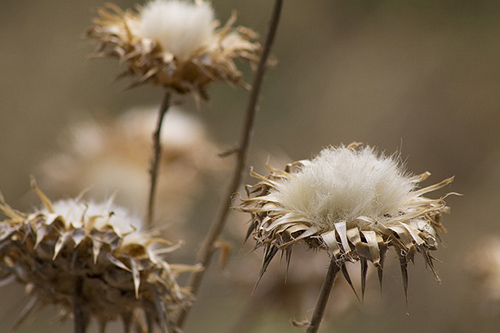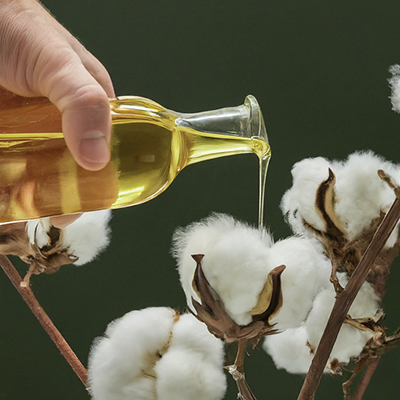Contents
The Cotton plant is called hydrophilous (a word which means “friend of water,” from an etymological standpoint) because it can quickly absorb vast amounts of liquid; these properties make skin covered with a cotton bandage stay clean and dry.
This plant not only gives us clothes but also helps us to overcome many diseases.
Andres de Laguna
Cotton Plant Scientific Facts

- French: Cottonier
- Spanish: Algodonero
- Environment: Native to Asia, this plant is currently cultivated in hot regions worldwide.
- Description: Herbaceous plant of the Mauvaceae family, growing up to one meter high. Its leaves are divided into three or five lobules. It has solitary, exuberant flowers with five yellow or white petals, each with a purple stain in its base. The fruit is an egg-shaped capsule, 5-6cm sized, containing several seeds covered with a white fiber: cotton.
- Parts of the plant used medicinally: The leaves, the flowers, the seeds, and the bark of the root.
Preparation and Use
- Seed oil: It is used in several pharmaceutical and food preparations.
- Infusion with leaves and flowers, in a proportion of 10g per liter of water. A handful of seeds can also be added. Drink three to four cups daily.
Cotton is the healthiest and most helpful textile fiber. It is ideal for clothes that directly touch the skin. Hydrophilous cotton is made of this fiber, and it is necessary to treat wounds and apply a wide range of cosmetic and medicinal products to the skin. Traditional cotton dressings are still the healthiest and easiest to use.
Healing Properties

The cotton plant seeds’ fiber is practically pure cellulose, with the tiniest cover of fatty substances and organic acids. Its absorbent and hydrophilous properties render it the best dressing for wounds and bandages.
We must also remember that cotton is the cleanest and healthiest textile cloth, especially for underwear clothing. Besides having absorbent properties, it does not produce allergic reactions, as synthetic fibers frequently do.
The cotton plant seeds contain 20% oil, rich in polyunsaturated fatty acids, which is recommended for those suffering from excess cholesterol in the blood. Hence, cotton plant seed oil is used in the pharmaceutical and food industries as well as soap and cosmetic making due to its emollient properties on the skin.

The cotton plant’s leaves and flowers are rich in mucilages and have emollient (skin and inflamed mucosa soothing) and pectoral properties. They are used as an infusion for bronchial catarrh to soften secretions and reduce the inflammation of the respiratory airways. They are also helpful for dysentery or colitis due to their emollient and anti-inflammatory properties on the intestinal mucosa.
The bark of the root of the cotton plant contains substances with oxytocic properties, similar to the alkaloids of the rye ergot, which stimulate uterine contractions. It was formerly administered for difficult labor and to stop uterine hemorrhages since contracting the uterus stops bleeding. It also has emmenagogue properties; that is, it promotes and provokes menstruation. It is no longer used for these purposes since we have more powerful and safer alternatives.
Eight Other Health Benefits of The Cotton Plant

1. Cottonseed Oil: Cottonseed oil is generated from the seeds of the cotton plant and includes a high application of vitamin E. This antioxidant can aid in the battle against free radicals inside the body. Cottonseed oil is created from the seeds of the cotton plant. As a consequence of this, it can lessen the effects of oxidative stress dramatically and could also lessen the likelihood of developing chronic disorders like cancer and heart disease. Additionally, it may be used in the kitchen and as a salad dressing.
2. Dietary Fiber: Cotton plants produce dietary fiber that can benefit gut health. While not directly consumed, the byproducts of cotton processing can be used in creating dietary fiber supplements.
3. Antimicrobial Properties: Some studies suggest that cotton plant extracts, including those from leaves and stalks, have antimicrobial properties and can be used in developing natural antimicrobial agents to help fight off infections.
4. Cottonseed Meal: The residual cottonseed meal, which is high in protein and can be utilized as a nutritional supplement in animal feed, is obtained after the oil has been extracted from rice. Though not directly a health benefit for humans, it contributes to the sustainable production of high-protein animal feeds.
5. Antioxidant Properties: In addition to vitamin E, cottonseed oil and other plant components include a variety of additional antioxidants that can shield the body from detrimental effects caused by free radicals.
6. Linoleic Acid: Linoleic acid is an essential component for human health within polyunsaturated fatty acids. Cottonseed oil has a high proportion of linoleic acid present in its composition. In addition to playing a vital part in brain function, it may also help reduce the chance of developing heart disease.
7. Phytosterols: These compounds in cottonseed oil are known for their cholesterol-lowering properties. It is possible that they will assist in reducing the amount of cholesterol absorbed in the intestines, which might result in lower cholesterol levels in the blood circulation.
8. Traditional Medicinal Uses: In some traditional medicine systems, various parts of the cotton plant treat ailments such as nausea, fever, headache, and menstrual discomfort, though scientific evidence supporting these uses may vary.
DISCLAIMER: All content on this website is presented solely for educational and informational objectives. It would be best to not rely on the information provided as a replacement for advice, diagnosis, or treatment from a qualified medical expert. If you are pregnant, nursing, or have any preexisting medical concerns, you should talk to your doctor before using any herbal or natural medicines.
REFERENCES
- George D. Pamplona-Roger, M.D. “Encyclopedia of Medicinal Plants.” George D. Pamplona-Roger, M.D. Encyclopedia of Medicinal Plants. Ed. Francesc X. Gelabert. vols. 2 San Fernando de Henares: Editorial Safeliz, 2000. 710,711. Print.
- PubMed: https://pubmed.ncbi.nlm.nih.gov/
- Google Scholar: https://scholar.google.com
